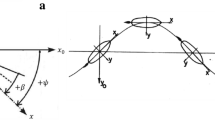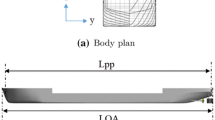Abstract
Restricted waters impose significant effects on ship navigation. In particular, with the presence of a side bank in the vicinity of the hull, the flow is greatly complicated. Additional hydrodynamic forces and moments act on the hull, thus changing the ship's maneuverability. In this paper, computational fluid dynamics methods are utilized for investigating the bank effects on a tanker hull. The tanker moves straight ahead at a low speed in two canals, characterized by surface piercing and sloping banks. For varying water depth and ship-to-bank distance, the sinkage and trim, as well as the viscous hydrodynamic forces on the hull, are predicted by a steady state Reynolds averaged Navier–Stokes solver with the double model approximation to simulate the flat free surface. A potential flow method is also applied to evaluate the effect of waves and viscosity on the solutions. The focus is placed on verification and validation based on a grid convergence study and comparisons with experimental data. There is also an exploration of the modeling errors in the numerical method.




















Similar content being viewed by others
References
(2009) International conference on ship maneuvering in shallow and confined water: bank effects. Antwerp, Belgium. http://www.bankeffects.ugent.be/index.html
Norrbin N (1974) Bank effects on a ship moving through a short dredged channel. In: 10th Symposium on naval hydrodynamics, Cambridge, MA, USA
Norrbin N (1985) Bank clearance and optimal section shape for ship canals. In: 26th PIANC international navigation congress, Brussels, Belgium, Section 1, Subject 1, pp 167–178
Li DQ, Leer-Andersen M, Ottosson P, Trägårdh P (2001) Experimental investigation of bank effects under extreme conditions. Practical design of ships and other floating structures. Elsevier Science Ltd, Oxford, pp 541–546
Ch’ng PW, Doctors LJ, Renilson MR (1993) A method of calculating the ship–bank interaction forces and moments in restricted water. Int Shipbuild Prog 40(421):7–23
Vantorre M, Delefortrie G et al (2003) Experimental investigation of ship–bank interaction forces. In: Proceedings of international conference on marine simulation and ship maneuverability, MARSIM’03, Kanazawa, Japan
Lataire E, Vantorre M, Eloot K (2009) Systematic model tests on ship–bank interaction effects. In: International conference on ship maneuvering in shallow and confined water: bank effects (2009), Antwerp, Belgium
Newman JN (1992) The green function for potential flow in a rectangular channel. J Eng Math (Anniversary Issue):51–59
Miao QM, Xia JZ, Chwang AT, et al (2003) Numerical study of bank effects on a ship travelling in a channel. In: Proceedings of 8th international conference on numerical ship hydrodynamics, Busan, Korea
Lee CK, Lee SG (2008) Investigation of ship maneuvering with hydrodynamic effects between ship and bank. J Mech Sci Technol 22(6):1230–1236
Lo DC, Su DT, Chen JM (2009) Application of computational fluid dynamics simulations to the analysis of bank effects in restricted waters. J Navig 62:477–491
Wang HM, Zou ZJ, Xie YH, Kong WL (2010) Numerical study of viscous hydrodynamic forces on a ship navigating near bank in shallow water. In: Proceedings of the twentieth (2010) international offshore and polar engineering conference, Beijing, China
Larsson L, Raven H (2010) Ship resistance and flow. Society of Naval Architects and Marine Engineers, New York. ISBN/ISSN: 978-0-939773-76-3
Broberg L, Regnström B, Östberg M (2007) SHIPFLOW theoretical manual. FLOWTECH International AB, Gothenburg
Deng GB, Queutey P, Visonneau M (2005) Three-dimensional flow computation with Reynolds stress and algebraic stress models. In: Rodi W, Mulas M (eds) Engineering turbulence modeling and experiments, vol 6. Elsevier, Amsterdam, pp 389–398
Menter FR (1993) Zonal two equation k–ω turbulence models for aerodynamic flows. In: 24th Fluid dynamics conference, Orlando, AIAA paper, 93-2906
Roe PL (1981) Approximate Riemann solvers, parameter vectors, and difference schemes. J Comput Phys 43:357–372
Dick E, Linden J (1992) A multi-grid method for steady incompressible Navier–Stokes equations based on flux difference splitting. Int J Numer Methods Fluids 14:1311–1323
Hellsten A, Laine S (1997) Extension of the k–ω-SST turbulence model for flows over rough surfaces. AIAA-97-3577, pp 252–260
(2010) A workshop on numerical ship hydrodynamics. Gothenburg, Sweden. http://www.gothenburg2010.org/kvlcc2_gc.html
Eça L, Vaz G, Hoekstra M (2010) Code verification, solution verification and validation in RANS solvers. In: Proceedings of ASME 29th international conference OMAE2010, Shanghai, China
Eça L, Vaz G, Hoekstra M (2010) A verification and validation exercise for the flow over a backward facing step. In: Pereira JCF, Sequeira A (eds) V European conference on computational fluid dynamics, ECCOMAS CFD 2010, Lisbon, Portugal
Zou L, Larsson L, Delefortrie G, Lataire E (2011) CFD prediction and validation of ship–bank interaction in a canal. In: 2nd International conference on ship manoeuvring in shallow and confined water, Trondheim, Norway
ASME V&V 20-2009 (2009) Standard for verification and validation in computational fluid dynamics and heat transfer. American Society of Mechanical Engineers, New York
Delefortrie G, Eloot K, Mostaert F (2011) SIMMAN 2012: execution of model tests with KCS and KVLCC2. Version 2_0, WL Rapporten, 846_01, Flanders Hydraulics Research, Antwerp, Belgium
Zou L, Larsson L (2010) CFD prediction of the local flow around the KVLCC2 tanker in fixed condition. In: Proceedings of a workshop on numerical ship hydrodynamics, Gothenburg, Sweden
Acknowledgments
The present work was funded by Chalmers University of Technology, Sweden and the China Scholarship Council. Computing resources were provided by C3SE, Chalmers Centre for Computational Science and Engineering. The authors thank Mr. Guillaume Delefortrie (Flanders Hydraulics Research, Belgium) and Mr. Evert Lataire (Maritime Technology Division, Ghent University, Belgium) for providing the measurement data.
Author information
Authors and Affiliations
Corresponding author
About this article
Cite this article
Zou, L., Larsson, L. Computational fluid dynamics (CFD) prediction of bank effects including verification and validation. J Mar Sci Technol 18, 310–323 (2013). https://doi.org/10.1007/s00773-012-0209-7
Received:
Accepted:
Published:
Issue Date:
DOI: https://doi.org/10.1007/s00773-012-0209-7




